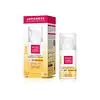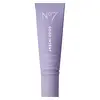What's inside
What's inside
 Key Ingredients
Key Ingredients

 Benefits
Benefits

 Concerns
Concerns

 Ingredients Side-by-side
Ingredients Side-by-side

Water
Skin ConditioningEthylhexyl Methoxycinnamate
UV AbsorberButylene Glycol
HumectantMethylene Bis-Benzotriazolyl Tetramethylbutylphenol
UV FilterDiethylamino Hydroxybenzoyl Hexyl Benzoate
UV FilterTriethylhexanoin
MaskingGlycerin
HumectantHydroxyethyl Acrylate/Sodium Acryloyldimethyl Taurate Copolymer
Emulsion StabilisingSodium Hyaluronate
HumectantHydrolyzed Hyaluronic Acid
HumectantSorbitan Sesquioleate
EmulsifyingPanthenol
Skin ConditioningXanthan Gum
EmulsifyingSodium Acetylated Hyaluronate
HumectantAlcohol
AntimicrobialDecyl Glucoside
CleansingPropylene Glycol
HumectantSqualane
EmollientPolysorbate 60
EmulsifyingSorbitan Isostearate
EmulsifyingDisodium EDTA
Propanediol
SolventCaprylhydroxamic Acid
BHT
AntioxidantPhenoxyethanol
PreservativeEthylhexylglycerin
Skin ConditioningWater, Ethylhexyl Methoxycinnamate, Butylene Glycol, Methylene Bis-Benzotriazolyl Tetramethylbutylphenol, Diethylamino Hydroxybenzoyl Hexyl Benzoate, Triethylhexanoin, Glycerin, Hydroxyethyl Acrylate/Sodium Acryloyldimethyl Taurate Copolymer, Sodium Hyaluronate, Hydrolyzed Hyaluronic Acid, Sorbitan Sesquioleate, Panthenol, Xanthan Gum, Sodium Acetylated Hyaluronate, Alcohol, Decyl Glucoside, Propylene Glycol, Squalane, Polysorbate 60, Sorbitan Isostearate, Disodium EDTA, Propanediol, Caprylhydroxamic Acid, BHT, Phenoxyethanol, Ethylhexylglycerin
Water
Skin ConditioningEthylhexyl Methoxycinnamate
UV AbsorberDipropylene Glycol
HumectantEthylhexyl Salicylate
UV AbsorberDimethicone
EmollientDiethylamino Hydroxybenzoyl Hexyl Benzoate
UV FilterC14-22 Alcohols
Emulsion StabilisingIsoamyl P-Methoxycinnamate
UV AbsorberBis-Ethylhexyloxyphenol Methoxyphenyl Triazine
Skin ConditioningTapioca Starch
Vp/Eicosene Copolymer
Silica
AbrasiveDibutyl Adipate
EmollientPhenoxyethanol
PreservativeC12-20 Alkyl Glucoside
EmulsifyingNiacinamide
SmoothingAcrylates/C12-22 Alkyl Methacrylate Copolymer
Potassium Cetyl Phosphate
EmulsifyingAmmonium Acryloyldimethyltaurate/Vp Copolymer
PEG-100 Stearate
Glyceryl Stearate
EmollientAllantoin
Skin ConditioningBisabolol
MaskingAloe Barbadensis Leaf Juice
Skin ConditioningXanthan Gum
EmulsifyingSodium Hyaluronate
HumectantEthylhexylglycerin
Skin ConditioningCaprylyl Glycol
EmollientArginine
MaskingCoco-Glucoside
CleansingDisodium EDTA
Dipotassium Glycyrrhizate
HumectantTocopherol
AntioxidantGlycerin
HumectantPolymethylsilsesquioxane
Disodium Lauryl Sulfosuccinate
CleansingOctyldodecanol
Emollient1,2-Hexanediol
Skin ConditioningCarnosine
Skin ConditioningHydroxyacetophenone
AntioxidantHydrogenated Lecithin
EmulsifyingBHT
AntioxidantCeramide NP
Skin ConditioningPolyglyceryl-10 Stearate
Skin ConditioningSucrose Stearate
EmollientLinoleic Acid
CleansingPhytosphingosine
Skin ConditioningCholesterol
EmollientPhospholipids
Skin ConditioningCeramide Ng
Skin ConditioningCeramide As
Skin ConditioningCeramide AP
Skin ConditioningCeramide EOP
Skin ConditioningWater, Ethylhexyl Methoxycinnamate, Dipropylene Glycol, Ethylhexyl Salicylate, Dimethicone, Diethylamino Hydroxybenzoyl Hexyl Benzoate, C14-22 Alcohols, Isoamyl P-Methoxycinnamate, Bis-Ethylhexyloxyphenol Methoxyphenyl Triazine, Tapioca Starch, Vp/Eicosene Copolymer, Silica, Dibutyl Adipate, Phenoxyethanol, C12-20 Alkyl Glucoside, Niacinamide, Acrylates/C12-22 Alkyl Methacrylate Copolymer, Potassium Cetyl Phosphate, Ammonium Acryloyldimethyltaurate/Vp Copolymer, PEG-100 Stearate, Glyceryl Stearate, Allantoin, Bisabolol, Aloe Barbadensis Leaf Juice, Xanthan Gum, Sodium Hyaluronate, Ethylhexylglycerin, Caprylyl Glycol, Arginine, Coco-Glucoside, Disodium EDTA, Dipotassium Glycyrrhizate, Tocopherol, Glycerin, Polymethylsilsesquioxane, Disodium Lauryl Sulfosuccinate, Octyldodecanol, 1,2-Hexanediol, Carnosine, Hydroxyacetophenone, Hydrogenated Lecithin, BHT, Ceramide NP, Polyglyceryl-10 Stearate, Sucrose Stearate, Linoleic Acid, Phytosphingosine, Cholesterol, Phospholipids, Ceramide Ng, Ceramide As, Ceramide AP, Ceramide EOP
 Reviews
Reviews

Ingredients Explained
These ingredients are found in both products.
Ingredients higher up in an ingredient list are typically present in a larger amount.
BHT is a synthetic antioxidant and preservative.
As an antioxidant, it helps your body fight off free-radicals. Free-radicals are molecules that may damage your skin cells.
As a preservative, it is used to stabilize products and prevent them from degrading. Specifically, BHT prevents degradation from oxidation.
The concerns related to BHT come from oral studies; this ingredient is currently allowed for use by both the FDA and EU.
However, it was recently restricted for use in the UK as of April 2024.
Learn more about BHTDiethylamino Hydroxybenzoyl Hexyl Benzoate (DHHB) is a chemical UV-A absorber. It is formulated for high UVA protection (320-400 nm).
DHHB is well-liked for:
DHHB has been approved by the EU, Japan, Taiwan, and South America for use up to 10%. Unfortunately, it has not been approved for use in the US or Canada due to slow regulatory processes.
This ingredient is soluble in oils, fats, and lipids.
Learn more about Diethylamino Hydroxybenzoyl Hexyl BenzoateDisodium EDTA plays a role in making products more stable by aiding other preservatives.
It is a chelating agent, meaning it neutralizes metal ions that may be found in a product.
Disodium EDTA is a salt of edetic acid and is found to be safe in cosmetic ingredients.
Learn more about Disodium EDTAEthylhexyl Methoxycinnamate is an organic compound that provides UVB protection. It often goes by the more common name of octinoxate. It is created from methoxycinnamic acid and 2-ethylhexanol.
Ethylhexyl Methoxycinnamate absorbs UVB rays with wavelengths between 280-320 nm. UV absorbers protect your skin by using chemical reactions to convert UV rays into heat and energy.
UVB (290-320 nm) rays emit more energy than UVA rays. They are capable of damaging DNA, causing sunburns and are thought to be linked to skin cancer.
The state of Hawaii has banned sunscreens containing octinoxate due to its potential impact on coral reefs. More research is needed to bridge gaps in this research. The European Union allows higher levels of octinoxate in sunscreens than the US and Australia.
Ethylhexyl Methoxycinnamate is oil soluble. It is not stable and may lose efficacy when exposed to sunlight.
Learn more about Ethylhexyl MethoxycinnamateEthylhexylglycerin (we can't pronounce this either) is commonly used as a preservative and skin softener. It is derived from glyceryl.
You might see Ethylhexylglycerin often paired with other preservatives such as phenoxyethanol. Ethylhexylglycerin has been found to increase the effectiveness of these other preservatives.
Glycerin is already naturally found in your skin. It helps moisturize and protect your skin.
A study from 2016 found glycerin to be more effective as a humectant than AHAs and hyaluronic acid.
As a humectant, it helps the skin stay hydrated by pulling moisture to your skin. The low molecular weight of glycerin allows it to pull moisture into the deeper layers of your skin.
Hydrated skin improves your skin barrier; Your skin barrier helps protect against irritants and bacteria.
Glycerin has also been found to have antimicrobial and antiviral properties. Due to these properties, glycerin is often used in wound and burn treatments.
In cosmetics, glycerin is usually derived from plants such as soybean or palm. However, it can also be sourced from animals, such as tallow or animal fat.
This ingredient is organic, colorless, odorless, and non-toxic.
Glycerin is the name for this ingredient in American English. British English uses Glycerol/Glycerine.
Learn more about GlycerinPhenoxyethanol is a preservative that has germicide, antimicrobial, and aromatic properties. Studies show that phenoxyethanol can prevent microbial growth. By itself, it has a scent that is similar to that of a rose.
It's often used in formulations along with Caprylyl Glycol to preserve the shelf life of products.
Sodium Hyaluronate is hyaluronic acid's salt form. It is commonly derived from the sodium salt of hyaluronic acid.
Like hyaluronic acid, it is great at holding water and acts as a humectant. This makes it a great skin hydrating ingredient.
Sodium Hyaluronate is naturally occurring in our bodies and is mostly found in eye fluid and joints.
These are some other common types of Hyaluronic Acid:
Learn more about Sodium HyaluronateWater. It's the most common cosmetic ingredient of all. You'll usually see it at the top of ingredient lists, meaning that it makes up the largest part of the product.
So why is it so popular? Water most often acts as a solvent - this means that it helps dissolve other ingredients into the formulation.
You'll also recognize water as that liquid we all need to stay alive. If you see this, drink a glass of water. Stay hydrated!
Learn more about WaterXanthan gum is used as a stabilizer and thickener within cosmetic products. It helps give products a sticky, thick feeling - preventing them from being too runny.
On the technical side of things, xanthan gum is a polysaccharide - a combination consisting of multiple sugar molecules bonded together.
Xanthan gum is a pretty common and great ingredient. It is a natural, non-toxic, non-irritating ingredient that is also commonly used in food products.
Learn more about Xanthan Gum